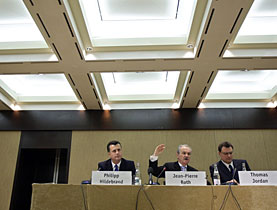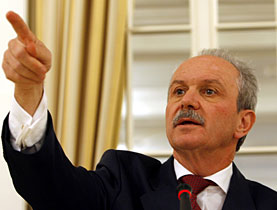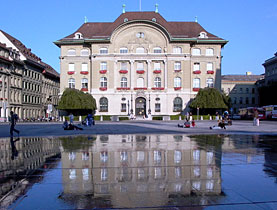Central bank “vigilant” as economy cools

The Swiss National Bank (SNB) will keep its key interest rate unchanged at 2.75 per cent despite inflation rising to a 15-year high of 2.9 per cent in May.
The central bank said the inflationary trend was “temporary” and that the expected slowdown in the economy should have a moderating effect, bringing inflation below the two per cent level in 2009.
It is the third time in nine months that the SNB has held steady the band in which interest rates move, at 2.25 per cent to 3.25 per cent, as it weighs up the risks of rising inflation against slowing economic growth.
“Given the prevailing uncertainty as regards both the global economy – which could suffer a greater-than-expected slowdown – and the fallout from the international financial turmoil, which has hit Switzerland fairly hard compared to other industrial countries, we consider that a prudent attitude remains appropriate and that a change of monetary policy is not called for in the current circumstances,” SNB President Jean-Pierre Roth told journalists in Geneva on Thursday.
The central bank raised its inflation forecast for 2008 to 2.7 per cent from two per cent and its forecast for 2009 to 1.7 per cent from 1.4 per cent. But it lowered its key medium-term forecast for 2010 to 1.3 per cent.
“There is enough reason to suggest that the current inflationary trend is of a transitory nature,” said Roth. But he admitted that there were “significant risks” attached to this favourable forecast and the bank would remain “very vigilant”.
“A renewed rise in energy prices, a stronger economy than expected, a weakening of the Swiss franc or an increase in inflation expectations would pose a threat to medium-term price stability,” noted the president.
Overall, the SNB’s assessment raised some eyebrows.
“We’re slightly surprised,” Bank of America economist Gilles Moec told Reuters. “It is one thing not to raise rates when inflation reached its highest point in nearly 15 years and it is another to send this dovish message for the near future.”
Economic growth
Growth slowed sharply in the Swiss economy in the first quarter of 2008. Real GDP grew at a rate of only 1.3 per cent from January to March, compared with growth rates of three to four per cent in 2007.
Roth called the slowdown both inevitable and desirable, and said it was the result of the bank’s prior intervention in the economy, designed to prevent it from overheating.
The SNB is maintaining its GDP forecast of between 1.5 per cent and two per cent for 2008.
According to the central bank, the slowdown in production has not spread to all sectors of activity. Domestic demand remains – on the whole – robust and further growth in demand and production is likely over the next few quarters, albeit at a more modest pace.
Although high prices for oil products and uncertainty related to the US real estate crisis will undoubtedly continue to hamper economic activity, growth in household consumption and equipment investment looks set to continue, the SNB stated.
Greater resilience
The central bank also laid out its blueprint for a stronger banking system in its annual financial stability report on Thursday, urging banks to build a bigger financial cushion to avoid a repeat of the subprime mortgage crisis.
“In each of the three most recent international financial crises, a large Swiss bank was particularly hit,” SNB Vice-chairman Philipp Hildebrand told journalists. “If the wheels are not set in motion now, the impact of the next crisis could be even more severe. Should a big bank collapse, the consequences for Switzerland would be dire.”
The SNB is calling for a “higher capital buffer at big banks” given their dominance in Switzerland.
“Their size and importance for the Swiss economy justifies especially prudent decision making when determining the level of their capital base,” according to the report.
The SNB wants tighter risk-weighted capital requirements and to introduce a so-called leverage ratio, which would force banks to put more money aside to cover risks.
“The leverage of the Swiss banks is particularly high,” the report says. “As the current turmoil has shown, one consequence of high leverage is that losses which are small in comparison to a bank’s assets can deplete a significant portion of its capital.”
Switzerland is still reeling from the shock of seeing its big banks report huge losses last year. UBS announced $37 billion (SFr37.6 billion) losses in 2007 as a result of a breakdown in risk management procedures and Credit Suisse posted a small profit of SFr7.8 billion after also suffering from the subprime loans turmoil.
swissinfo, Simon Bradley
Switzerland’s central bank is independent of the government and is free to set interest rates.
Its policy goal is price stability, which it says is an important precondition for economic growth and prosperity.
It bases its monetary policy on a medium-term inflation forecast.
Its chosen reference interest is the three-month Libor rate (London Interbank Offered Rate).
Its profit is broadly speaking divided up among the cantons (two-thirds) and the federal government.
(2008, 2009, publication)
Seco 1.9, 1.7, 20.12.2007
SNB 1.5-2.0, – , 13.03.2008
UBS 1.5, 1.6, 28.01.2008
Credit Suisse 1.9, 1.6, 12.03.2008
KOF 2.1, 1.9, 17.12.2007
BAK Basel Economics 2.1, 2.0, 12.03.2008
OECD 2.0, 2.0, 06.12.2007

In compliance with the JTI standards
More: SWI swissinfo.ch certified by the Journalism Trust Initiative




You can find an overview of ongoing debates with our journalists here. Please join us!
If you want to start a conversation about a topic raised in this article or want to report factual errors, email us at english@swissinfo.ch.